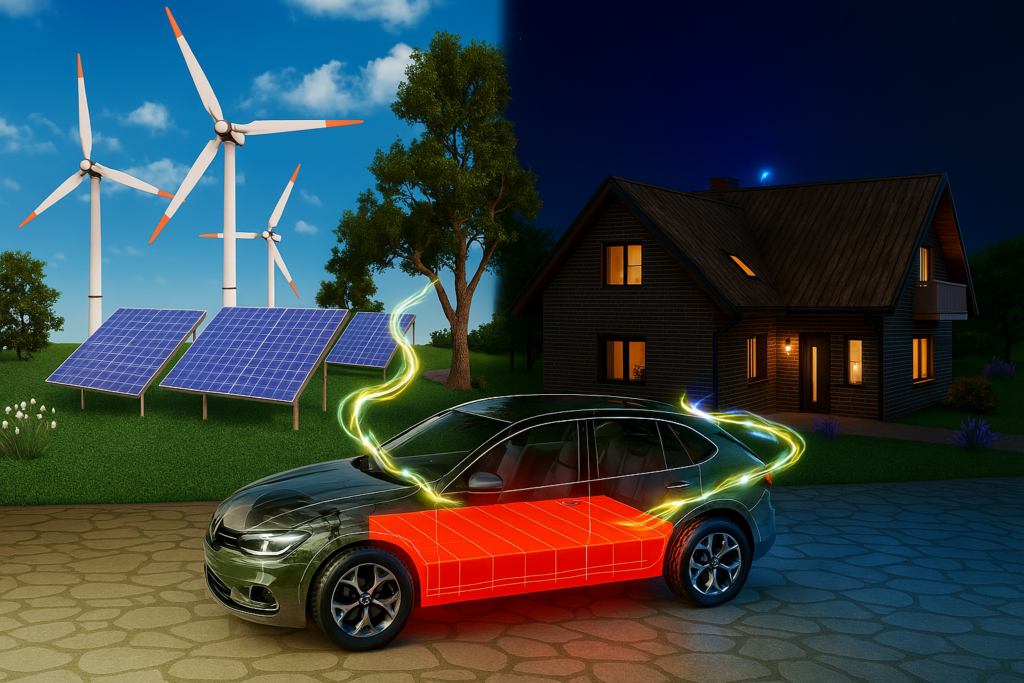In Kyiv, a Nissan Leaf hums quietly, powering a ventilator as missiles fall — proof EVs are more than just transport. From war-torn Ukraine to disaster-stricken Australia and the U.S., they’re proving to be mobile lifelines — powerbanks for resilience. They’re emerging as critical tools for energy resilience, transforming into mobile powerbanks that can keep the lights on when the grid goes down.
Power You Can Drive
Electric vehicles equipped with bi-directional charging capabilities — Vehicle-to-Load (V2L), Vehicle-to-Home (V2H), and Vehicle-to-Grid (V2G) — are redefining emergency preparedness. These systems let EVs power anything from a laptop to a house, or even feed electricity back into the grid. These EVs can supply electricity to power:
- Essential household appliances (fridges, lights, heaters)
- Communication devices (phones, radios, laptops)
- Life-saving medical equipment
- Even entire homes, for hours or days, depending on battery size
Preliminary research published in Energy in 2023 modeled how EVs with V2H capabilities could support households during extremely severe power loss events. Even a single EV can support an average home for multiple days with optimized usage, establishing vehicle-based power as a viable resilience strategy.
Bigger Batteries, Bigger Backup Potential
Battery Electric Vehicles (BEVs) are particularly well-suited for backup power because of their large battery capacities. Not all BEVs offer the same level of utility, however. While Tesla vehicles like the Model 3 and Model Y have large batteries, they don’t natively support V2L. Using them for home backup power requires third-party adapters or the upcoming Powershare system (currently only available on the Cybertruck). While adoption is growing, V2L availability varies by region, and retrofitting older EVs can cost over $2,000. In contrast, the Hyundai Ioniq 5, Kia EV6, and BYD Atto 3 come standard with plug-and-play V2L support.
As of 2023, the average BEV battery size is around 62.5 kWh, compared to only 21.8 kWh for PHEVs — a near threefold difference. For context, a Tesla Powerwall stores 13.5 kWh, enough to power a home for about half a day. A BEV with 62.5 kWh can potentially power the same home for over two days.
Take the Geely EX5, an LFP (lithium iron phosphate) battery-based BEV now available in Australia. Known for its safety and long cycle life, the EX5 offers a 60.22 kWh battery and starts from $41,000 AUD. It functions as both a reliable daily vehicle and an emergency energy source.
Real-World Resilience in Action
In Texas, a Ford F-150 Lightning powered a neighborhood grill during a 2024 blackout — turning a crisis into a community cookout. From warzones to backyard gatherings, EVs are proving their value in every kind of blackout — sometimes saving lives, other times saving dinner.
“When the lights went out after the missile strike, our Nissan Leaf powered 30 phones and a ventilator for three days straight,” says Kyiv resident Anna Kovalenko. Her EV turned into a lifeline — a story repeating across Ukraine, where grid infrastructure is under frequent attack. Residents are using EVs to power bomb shelters, command posts, and mobile aid stations — often pairing them with portable solar panels to create makeshift microgrids.
In Australia, where floods and bushfires threaten power access, V2L-capable EVs like the Hyundai Ioniq 5 and BYD Atto 3 have been used to power:
- CPAP machines and medical equipment
- Fridges and freezers with perishable goods
- Work-from-home setups during blackouts
In the U.S., following hurricanes and wildfires, EVs have powered community shelters and homes when paired with rooftop solar. In Canada, which is seeing more frequent fire seasons, EVs are being included in emergency planning — serving as mobile energy hubs for refrigeration and communications.
Africa & South America: EVs Where the Grid Can’t Reach
In sub-Saharan Africa, where grid access is limited, EVs are already improving energy access. ZOLA Electric in Rwanda integrates solar, batteries, and EVs into village microgrids. In Zimbabwe, over 190 solar-powered Hambas — electric tricycles with 5 kWh batteries — are deployed to help rural women transport goods and provide power to small clinics. Each battery can run a refrigeration unit for up to 12 hours, serving as vital backup for medicine and vaccines.
In Nigeria, Revive Earth, a startup in Lagos, is testing solar-powered EV tuk-tuks to deliver energy to rural clinics and off-grid homes. In remote South American villages, EVs with V2H setups are being piloted to support resilience where grid outages are common.
The Solar-EV Synergy

This synergy lays the groundwork for a broader shift toward decentralized energy systems. In California, solar-EV homes stayed powered during 2024 wildfires, proving the combo’s real-world resilience.
Pairing EVs with rooftop solar creates a closed-loop, local energy system. Solar charges the EV during the day, and at night or during an outage, the EV can power the home. The 2023 Energy study noted that this synergy improves backup durations significantly. With multiple EVs coordinated within a neighborhood, community-wide resilience becomes possible.
Distributed Renewables: A Foundation for Resilience
While EVs are critical tools, their power multiplies when integrated into distributed renewable energy systems. Centralized grids are vulnerable to single points of failure — storms, cyberattacks, fuel shortages. Distributed generation using solar, wind, and batteries decentralizes energy production, enhancing security and speed of recovery.
According to the U.S. Department of Energy, distributed energy resources (DERs) cut grid risks, reduce transmission losses, and lower emissions — all while empowering communities with local control (energy.gov, epa.gov).
This model enables faster disaster recovery, local control, and better long-term sustainability.
The Bigger Picture
The energy resilience benefits of EVs and distributed renewables are still under-acknowledged. As climate change increases the frequency of natural disasters and geopolitical threats to energy supplies grow, local energy independence is no longer just a smart investment — it’s a lifeline.
Advocate for policies supporting V2L and distributed energy infrastructure. Ask automakers and dealers about bidirectional charging support. Consider resilience, not just range and price, when buying your next vehicle. Because one day, your car might be the only thing keeping the lights on.
This isn’t just about going green — it’s about saving lives. Your EV isn’t just a car; it’s a lifeline when the grid fails.
Bottom line: When the grid goes dark and the night creeps in, your EV stands ready — a lifeline on wheels, charged for whatever comes next.

